Authentic German Maultaschen
This post may contain affiliate links. See my disclosure policy.
An Authentic Homemade Maultaschen recipe just the way you know and love them from Germany! Save time by making and freezing the meat filling in advance, following our tips about the pasta dough, and make a double batch while you’re at it and freeze the Maultaschen so you can grab, thaw and cook them whenever the craving comes calling!
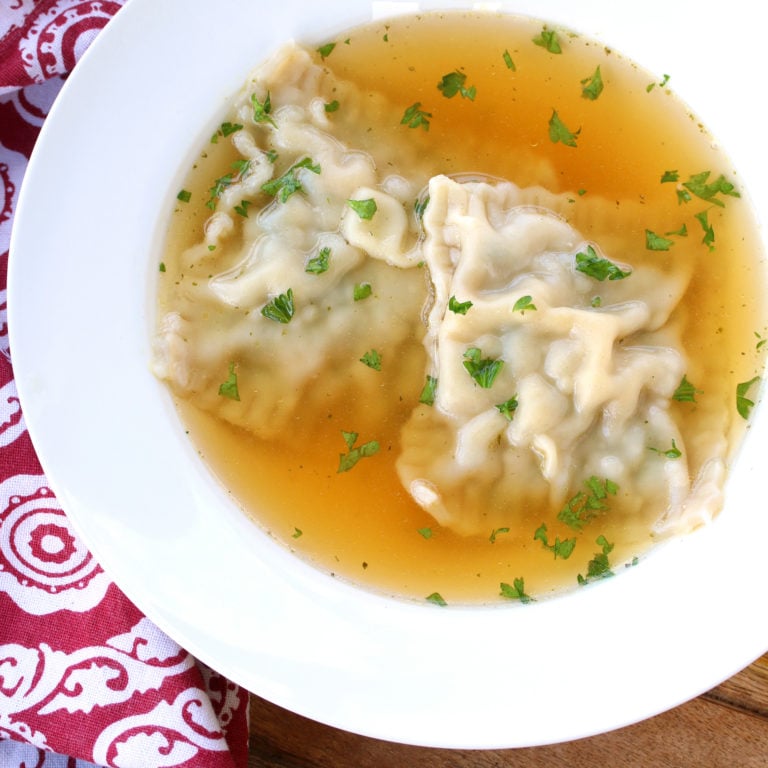
Homemade Maultaschen
As any Swabian will tell you, the Swabia region has the best cuisine in all of Germany. It’s true. And just one of many examples is Maultaschen…those wonderful pasta pockets filled with deliciously spiced meat, bread, onions and spinach. They’re Germany’s version of raviolis and they’re absolute heaven!
Maultaschen has always been one of my favorite German dishes and it’s something I frequently ordered when my family went out to eat in restaurants throughout southern Germany. Being from Stuttgart it was almost guaranteed that I would find them on every German restaurant’s menu. Now that I’ve moved to the U.S. it’s virtually impossible to find them. And if you do find them chances are they don’t taste like the real thing. And that’s why I make my own. These authentic homemade Maultaschen are the real deal. They taste just like the Maultaschen you know and love from Germany!
Where Did Maultaschen Originate?
Maultaschen have a long history and were traditionally associated with Lent, during which Catholics were to refrain from eating meat. The purpose in creating these pasta pockets was to sneak the meat inside of them thereby concealing it from the eyes of God. In this way the carnivorous Catholics could have their meat fix without calling down the lightning from heaven. In fact, there’s a Swabian nickname for Maultaschen, Herrgottsbescheißerle, which means “small God-cheaters.” And there you have it.
It is believed that Maultaschen were first created in the 17th century by the unruly Cistercian monks of the Maulbronn Abbey in the town of Maulbronn for that very purpose. The abbey is not far from where I grew up in Stuttgart. I’ve been there and I have to report that I found no trace of Maultaschen on its premises. But to be fair 500 years has a way of covering up such perishable evidence. So I’m happy to accept the tradition and give the monks full credit for this delicious dish that has since received official EU recognition as a regionally-protected speciality.
There are a few meanings attributable to the name Maultaschen (ie, maul means “mouth,” taschen means “pockets”) but the term Maul is commonly thought to have derived from the town of Maulbronn (Maultaschen being the shortened version of Maulbronn Taschen) and Taschen translates as “pockets,” describing the filled pasta.
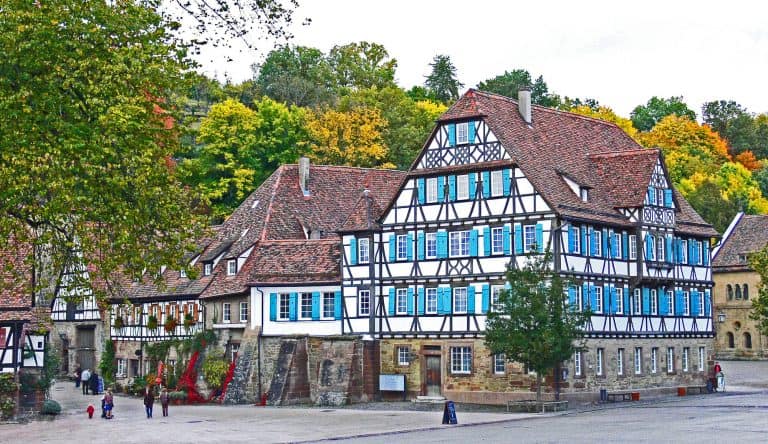

What is Bratwurstbrät?
One of the key ingredients in traditional Maultaschen is what’s called “Bratwurstbrät” in Germany. Without it you simply cannot replicate an authentic flavor.
Authentic German recipes usually call for a combination of ground meat (most commonly ground beef) and something called Bratwurstbrät. It’s the meat mixture that’s used to make German bratwursts (yes, we have a recipe for those too!). In Germany, like bulk Italian or bulk breakfast sausage, you can go to the butcher and get Bratwurstbrät. The challenge is that outside of Germany it’s nearly impossible to find.
And so I’ve developed a recipe for homemade Bratwurstbraet combined with the ground beef to make the Maultaschen filling. And it tastes exactly like the genuine stuff in Germany. Problem solved.
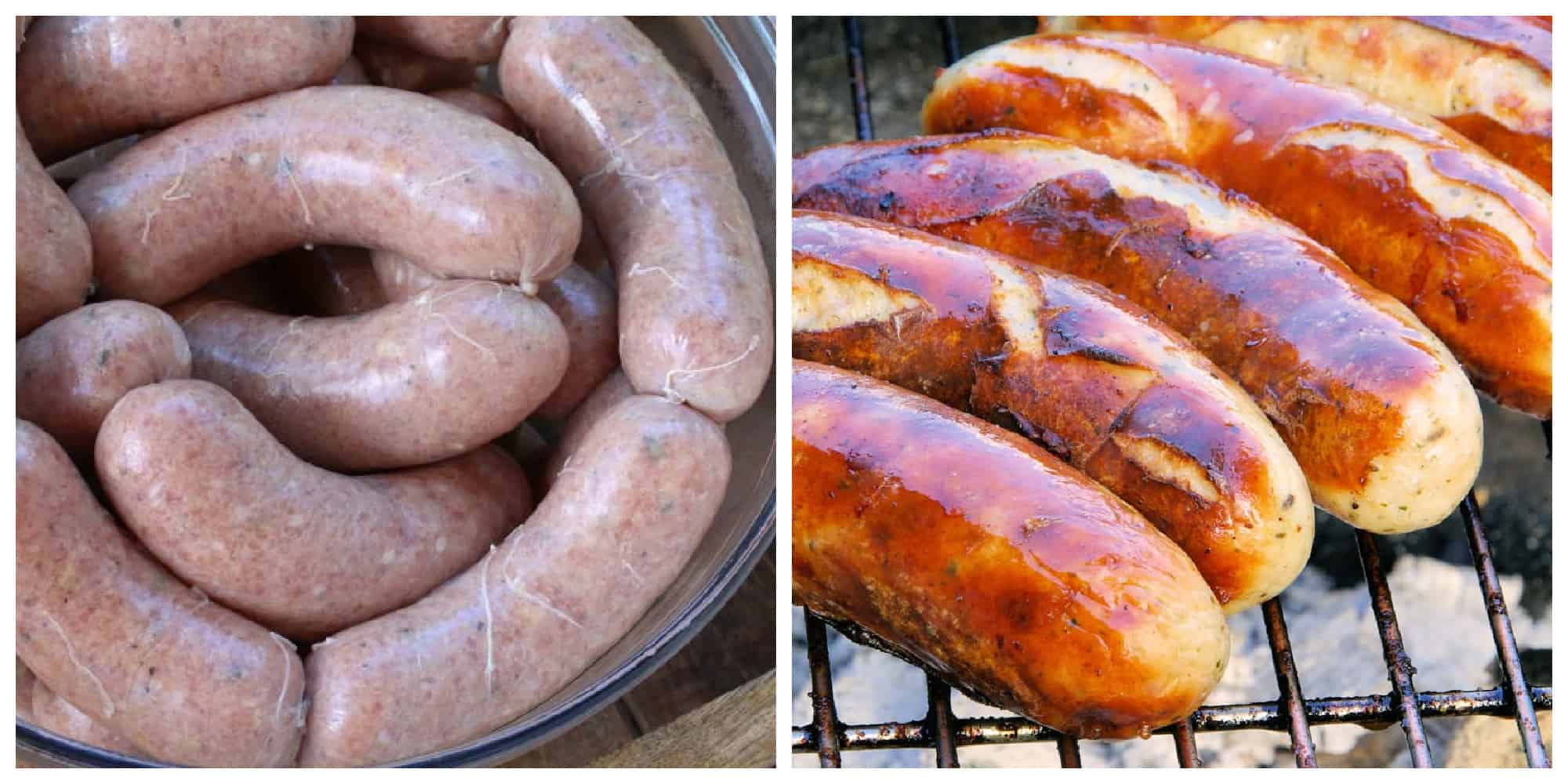
How To Make Bratwurstbrät
Technically, if you can find authentic German Bratwursts you could cut them and squeeze the filling out of them and use that for the Maultaschen filling (in place of the ground pork) along with ground beef. But all of the Bratwursts I’ve found here in the U.S. either taste nothing like authentic German Bratwursts or, in the case of imported ones that I’ve seen, they are pre-cooked so the filling can’t be used.
I’ve developed a recipe for homemade Bratwurstbraet that is combined with the ground beef to make the Maultaschen filling and it tastes exactly like the stuff you’ll find in Germany. Fry a little up and taste it and you’ll recognize the flavor as tasting just like authentic German Bratwursts. This is the filling I use to make my own German Bratwursts with the addition of a few other ingredients needed for the Bratwursts specifically. My Maultaschen filling will enable you to create those authentic-tasting Maultaschen that you know and love from Germany!
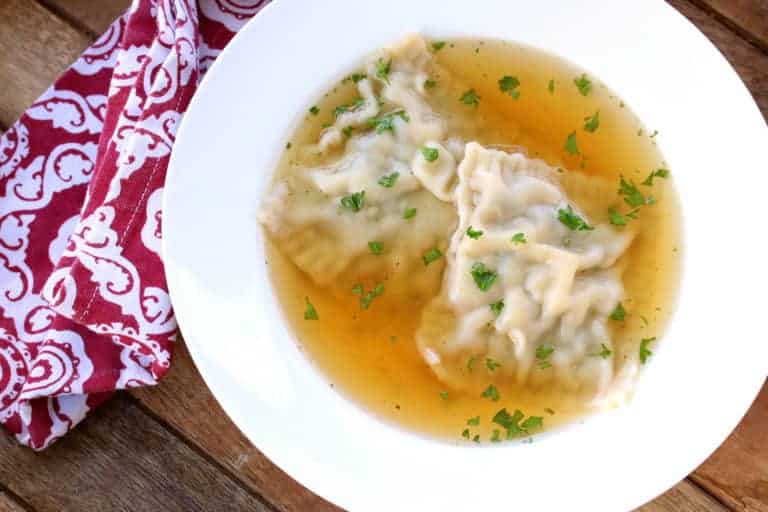
Make Sure the Meat Is Properly Mixed/”Emulsified” for the Right Texture
If you don’t have a stand mixer then don’t worry about this. But if you do and you’re determined to get the right texture, the key is making sure you adequately mix the meat until it is what’s called “emulsified”. Meaning if you take a clump of meat and pull it apart with your fingers you should see tiny threads pulling apart. This is the texture needed for making sausages and is what results in a smooth texture. Otherwise you’ll end up with a filling that is more crumbly in texture.
Is There a Shortcut?
Yes, you can use pre-ground meat from the store/butcher, half ground beef and half ground pork. You won’t have any control over the muscle-to-fat ratio so the texture won’t be as smooth but once you add the spices to it it should at least taste the same. Depending on the fat content of the ground meat (if the fat content is too low) it may not emulsify properly when you mix it in the stand mixer. But again, if you’re not too concerned about achieving the perfect texture and are more concerned just about achieving the perfect flavor, you don’t need to worry about that. The perfect texture aspect can be left to German food diehard types like me ;)
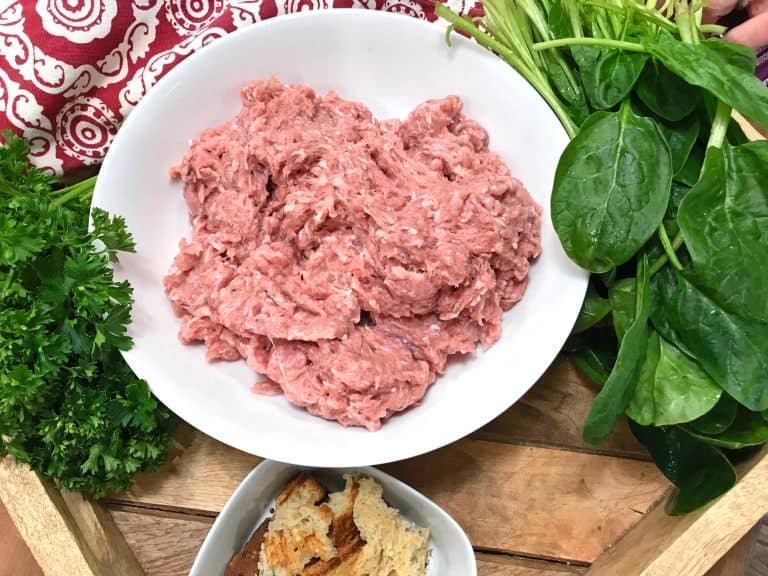
Maultaschen Recipe
Let’s get started!
If you’re using pre-ground beef and pork from the store, skip this step.
If you’re grinding your own meat, pork shoulder is an ideal cut because it has a good ratio of fat to muscle. Also when choosing a cut of beef (I get whatever’s on sale) don’t be afraid if it’s a fatty cut. That fat will help bind the meat when you mix it to create the ideal texture.

To make the Maultaschen filling, place the ground pork and beef, spices and milk powder in the bowl stand mixer fitted with a paddle attachment. Add about 1/2 cup crushed ice to the ground meat mixture in the stand mixture. This will keep the meat cold and prevent the fat from melting as the mixture is mixed/emulsified to create the desired texture.
Mix the meat on low-medium speed for a few minutes (be careful not to over-mix) until the mixture is emulsified. Meaning if you take a clump of meat and pull it apart with your fingers you should see tiny threads pulling apart.
Note: If you’re using pre-ground store-bought beef and pork it may not emulsify properly because of a lower fat content, in which case don’t worry about it and just move on to the next step.
Note: You can use the meat mixture immediately or you can freeze it so you can have it on hand for convenience to save time when you’re ready to make another batch of Maultaschen.
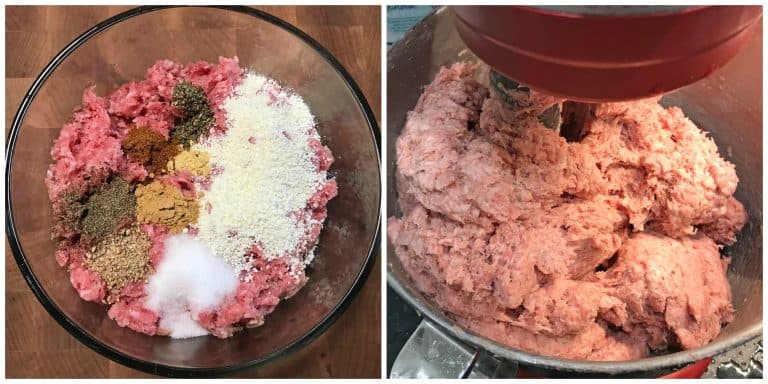
Now let’s prepare the other ingredients for the Maultaschen filling:
Boil the spinach for 1-2 minutes. Drain and rinse under cold water, thoroughly squeeze out the water and very finally chop it.
In a frying pan, heat the butter and saute the onion until soft and translucent, 5-7 minutes. Add the garlic and parsley and cook for another minute or two. Let the mixture cool down so it’s not super hot.
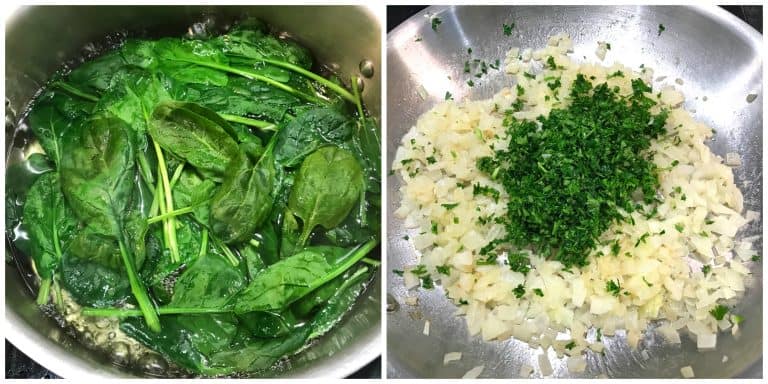
Put the meat mixture in a large bowl along with the onion/parsley mixture, the chopped spinach, prepared breadcrumbs, spices and eggs. Use a stand mixer or your hands to thoroughly combine the mixture.
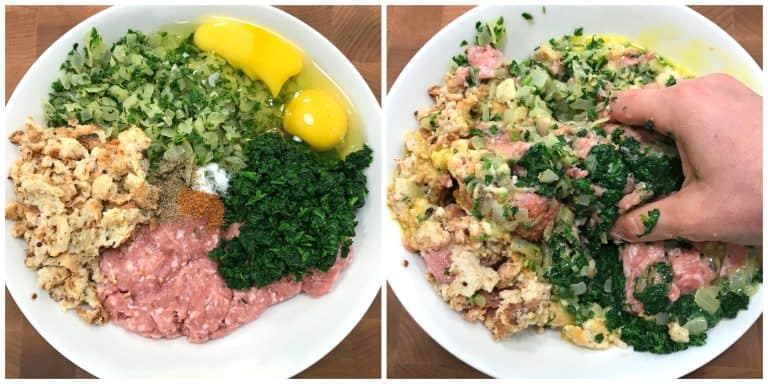
*NOTE: If you prefer an even finer texture you can run about one third or so of this mixture through the blender and then stir it back in to the rest of the mixture.
For the dough you can either use prepared sheets of pasta dough or you can use a shortcut: Wonton wrappers! Wonton wrappers are just basic pasta dough (flour, eggs, water) and they’re already pre-cut into just the right sized squares which makes them super convenient. And unless you have your own pasta machine and make your own sheets of pasta dough, wonton wrappers are WAY cheaper than store-bought fresh pasta sheets. My verdict: Wontons wrappers = Convenient, Easy, Cheaper & Taste the Same. Win-win!
I tend to be a traditionalist when it comes to preparing authentic dishes but if there are modern shortcuts that save time and effort and achieve the same results then I’m all for them!
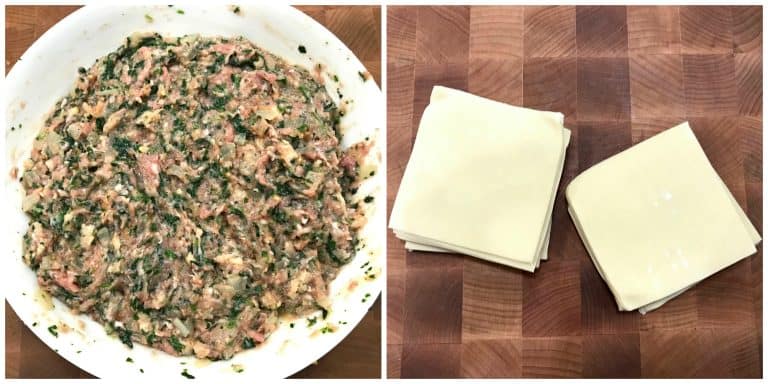
Place a small spoonful of Maultaschen filling on a square of pasta dough (about 3 1/2 x 3 1/2) leaving about 1/4 inch of space from the edges. Brush the edges with the egg, place another pasta square on top and press down with your fingers to seal.
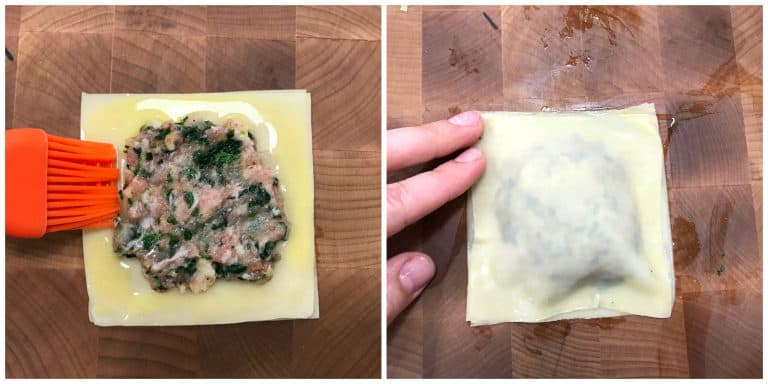
To ensure the edges are sealed tightly you can either use a fork to press the edges together or use a fluted pastry/pasta cutter wheel to make pretty edges.
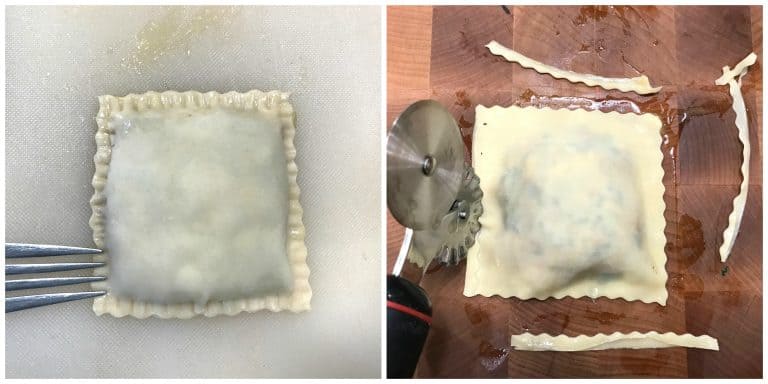
How to Freeze Maultaschen: For convenience you can freeze the Maultaschen at this point. Lay them out in a single layer on a lined cookie sheet and freeze them. Once frozen remove them and put them in an airtight container or ziplock bag and freeze for up to 3 months.
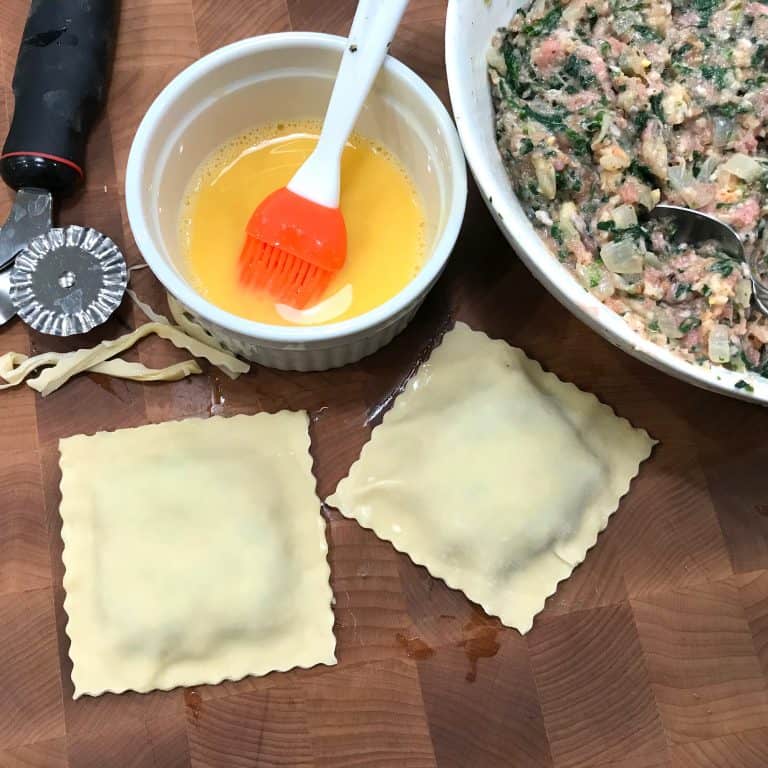
Now it’s time to cook the Maultaschen. Bring a large pot of lightly salted water to a low boil. Working in batches so as to not overcrowd, place the Maultaschen in the pot and keep the water at a very gentle simmer. Simmer for 10-15 minutes.
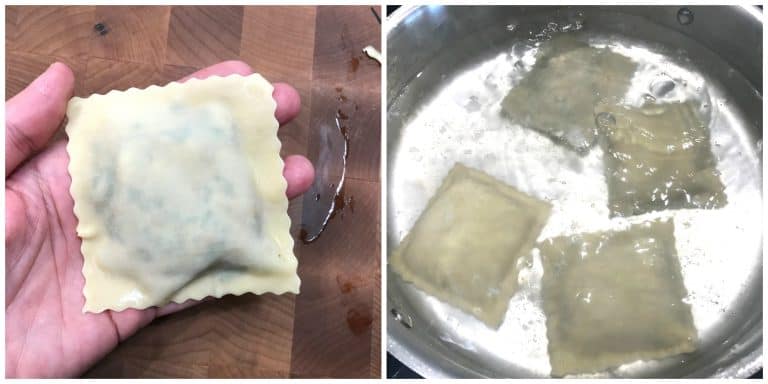
Remove the Maultaschen with a slotted spoon and transfer them to a colander to drain. Store them in an airtight container in the fridge until ready to use. They’ll keep for up to 3 days.
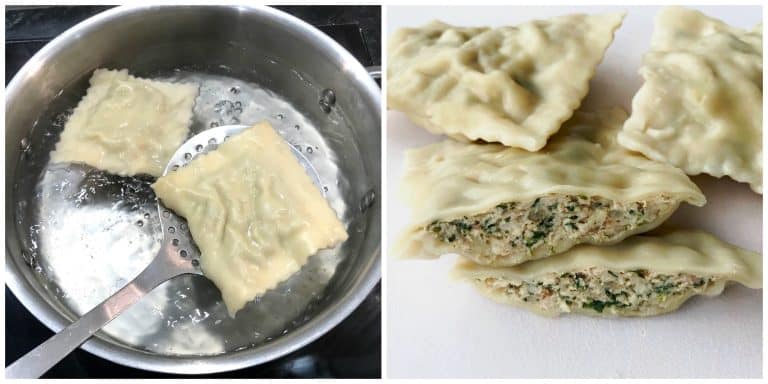
Can You Freeze Maultaschen?
Yes, Maultaschen can be frozen before they’re cooked. Make a double or triple batch while you’re at it so you can have Maultaschen on hand whenever the craving comes calling! After you fill the pasta and seal the Maultaschen shut, lay them out in a single layer on a lined cookie sheet and freeze them. Once frozen remove them and put them in an airtight container or ziplock bag and freeze for up to 3 months.
How To Serve Maultaschen
The ways are limited only by your imagination! The four most popular ways you’ll find them served in German restaurants are:
- Maultaschen in der Brühe: Served in broth (usually beef broth) and eaten as a soup.
- Geschmälzte Maultaschen: Fried in butter and served topped with caramelized onions)
- Gebratene Maultaschen mit Ei: The Maultaschen are sliced and fried in butter with beaten egg and herbs.
- Maultaschen Schweizer Art (Swiss style): Whole Maultaschen are baked with ham and Swiss cheese on top.
All four of these ways are popular and absolutely delicious. I encourage you to try them all!
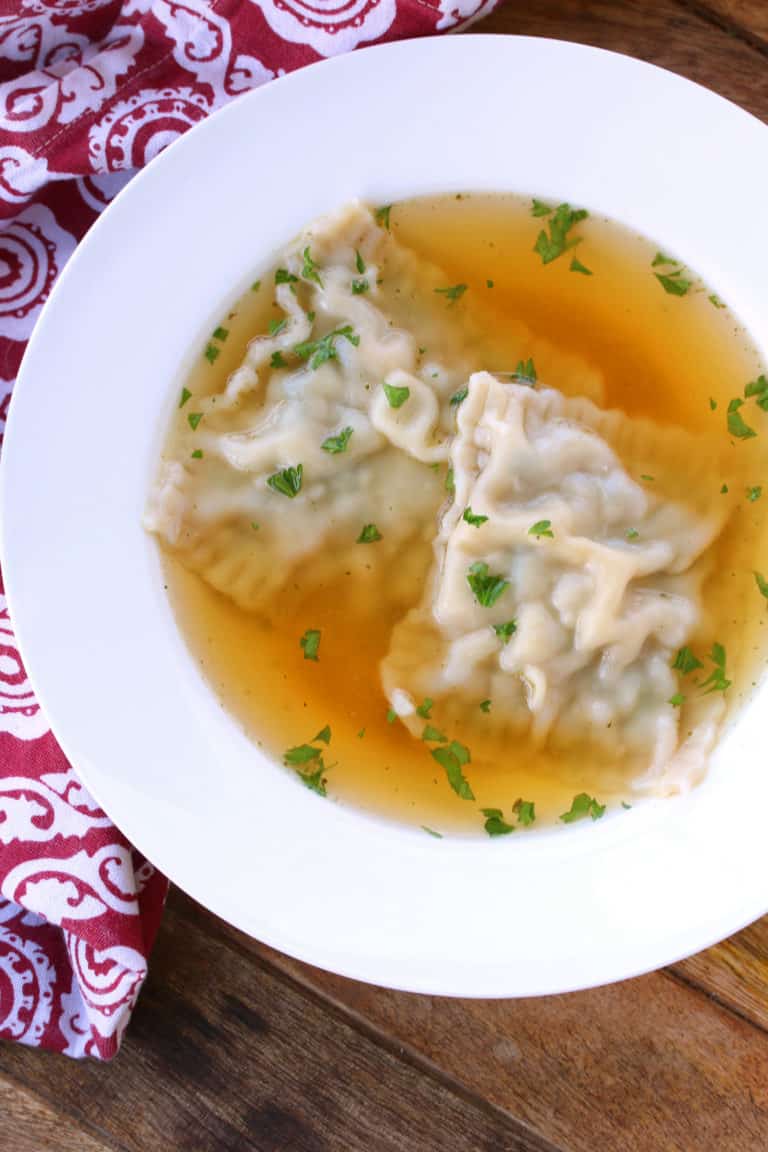
For more Authentic German Recipes to try my:
- Spätzle
- Käsespätzle
- Schnitzel
- Jägerschnitzel
- Sauerbraten
- Rouladen
- Schweinshaxe
- Königsberger Klopse
- German Potato Soup
- German Sauerkraut Soup
- German Potato Salad
- Currywurst
- Semmelknödel
- German Potato Dumplings
- Kartoffelpuffer
- German Plum Cake
- Vollkornbrot
- Rotkohl
- Zwiebelkuchen
Save This Recipe
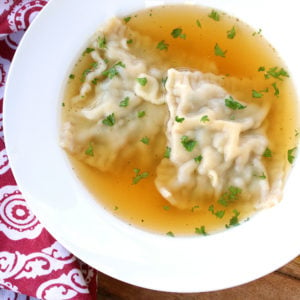
Authentic German Maultaschen
Ingredients
- 1 1/2 pounds fresh pasta sheets , cut into approx 3 1/2 x 3 1/2 inch squares
- OR 52 wonton wrappers , look for ones that contain egg in the ingredients (this is quicker, easier and tastes exactly the same *see blog post for more info)
- 1/2 pound ground pork (see note about grinding your own meat)
- 1/2 pound ground beef (see note about grinding your own meat)
- 1 1/4 teaspoons salt
- 1/2 teaspoon white pepper , freshly ground
- 1/4 teaspoon black pepper , freshly ground
- 1/3 teaspoon ground mace (can substitute nutmeg but strongly recommend mace for traditional German flavor)
- 1/3 teaspoon ground ginger
- 1/3 teaspoon dried marjoram
- 1/4 teaspoon mustard powder
- 1/8 teaspoon ground cardamom
- 1/8 teaspoon ground coriander
- 1 1/2 tablespoons non-fat milk powder (a standard ingredient in sausage-making, it helps bind the meat mixture, helps the cooked meat retain moisture and enhances the flavor. Omit if dairy-free.)
- 1/2 cup finely chopped parsley
- 1 tablespoon butter
- 1 medium yellow onion , very finely chopped
- 1 clove garlic , minced
- 1 bunch (6-8 ounces or 200 grams) spinach
- 2 large eggs
- 1/2 teaspoon salt
- 1/2 teaspoon freshly ground black pepper
- 1/4 teaspoon freshly ground nutmeg
- 8 ounces slightly stale crusty white bread (or fresh croutons) , chopped, placed in a bowl and softened with a few tablespoons of milk (squeeze out excess milk once softened)
Instructions
- **See the blog post for step-by-step photo instructions**
- Place the ground pork and beef, spices and milk powder in the bowl stand mixer fitted with a paddle attachment. Add about 1/2 cup crushed ice to the ground meat mixture in the stand mixture. This will keep the meat cold and prevent the fat from melting as the mixture is mixed/emulsified to create the desired texture.Mix the meat on low-medium speed for a few minutes (be careful not to
over-mix) until the mixture is emulsified. Meaning if you take a clump of
meat and pull it apart with your fingers you should see tiny threads pulling
apart. Set the meat mixture aside until ready to use.Note: If you're using pre-ground store-bought beef and pork it may not
emulsify properly because of a lower fat content, in which case don't worry
about it and just move on to the next step.Freezing the Meat Mixture: You can use the meat mixture immediately or you can freeze it so you can have it on hand for convenience to save time when you're ready to make
another batch of Maultaschen. - Boil the spinach for 1-2 minutes. Drain and rinse under cold water,
thoroughly squeeze out the water and very finally chop it. Set aside. - In a frying pan, heat the butter and saute the onion until soft and
translucent, 5-7 minutes. Add the garlic and parsley and cook for another minute or
two. Let the mixture cool down so it's not super hot. - Put the meat mixture in a large bowl along with the
onion/parsley mixture, the chopped spinach, prepared breadcrumbs, spices and
eggs. Use a stand mixer or your hands to thoroughly combine the mixture.NOTE: If you prefer an even finer texture you can
run about one third or so of this mixture through the blender and then stir it
back in to the rest of the mixture. - For the dough you can either use prepared sheets of pasta dough or you can
use a shortcut: Wonton wrappers. Wonton wrappers are just basic
pasta dough (flour, eggs, water) and they're already pre-cut into just the
right sized squares which makes them super convenient. And they're vastly cheaper than buying pre-made sheets of fresh pasta. Place a small spoonful of Maultaschen filling on a square of
fresh pasta dough (about 3 1/2 x 3 1/2) leaving about 1/4 inch of space from the
edges. Brush the edges with the egg, place another pasta square on top
and press down with your fingers to seal.To ensure the edges are sealed tightly you can either use a
fork to press the edges together or use a fluted pastry/pasta cutter wheel
to make pretty edges.How to Freeze Maultaschen: For convenience you can
freeze the Maultaschen at this point. Lay them out in a single layer on a
lined cookie sheet and freeze them. Once frozen remove them and put them
in an airtight container or ziplock bag and freeze for up to 3 months. - To cook the Maultaschen: Bring a large pot of lightly
salted water to a low boil. Working in batches so as to not overcrowd,
place the Maultaschen in the pot and keep the water at a very gentle
simmer. Simmer for 10-15 minutes.Remove the Maultaschen with a slotted spoon and transfer them to a colander
to drain. - To serve: The most traditional way Maultaschen in der Brühe which is warming the Maultaschen in a rich clear broth (usually beef broth) and serving it as a soup. There are other populars ways to serve Maultaschen (see blog post) and those recipes will follow!
Notes
has a good ratio of fat to muscle. Also when choosing a cut of beef (I
get whatever’s on sale) don’t be afraid if it’s a fatty cut. That fat
will help bind the meat when you mix it to create the ideal texture. Advance Preparation: You can save a lot of time by making the meat mixture in advance (the ground meat and spices) and freezing it until ready to use. You can also freeze the finished Maultaschen before they’re cooked. See note in directions.
Nutrition
Originally published on The Daring Gourmet September 13, 2019



















I lived and worked in that part of Germany for over a year. I biked from my town to Maulbronn and visited the Abbey. Of course, I had Maultaschen in der Brühe in the shade of the abbey before I rode back home. I’ve had your site bookmarked for ages because I make your sauerbraten recipe (which I absolutely love). I don’t know how I hadn’t found your Maultaschen until now. I’m hoping to make these myself when I can dig out my kitchenaid mixer from the boxes soon. Thanks so much for a great explanation. I’ll let you know how it goes for me.
Thank you for the feedback on the Sauerbraten, Mike, I’m so glad you enjoyed it! Those sound like such wonderful memories and I hope you likewise enjoy these Maultaschen and the walk down memory lane <3
Wonderful recipe, thank you!
Thank you, Miko, I’m happy you enjoyed it!
I want to try these. Can you use frozen spinach? I have made many of your recipes and they always great!!
Thank you so much for the compliment, Marilla! <3 And YES you can use frozen spinach, just thaw and drain it first.
I have been making these since I was a child with my grandfather, then my mother, and now with my own kids using an old family recipe very similar to yours. It was not until today that I actually tried to find more about this dish online and I was delighted to find this page! I used to roll out the pasta by hand, but recently bought a pasta maker which has helped tremendously. Based on the method I learned from my grandpa, we fill the whole sheet at once, spooning several scoops of filling along the length of one side of the pasta sheet, then fold it over, cut, and seal. It makes for some very irregularly-shaped maultaschen, but that’s part of what we love about them. I also cook the meat before adding the other filling ingredients, using my hands to get the texture really smooth, then assemble and boil them in the soup broth. I love when some break open and add flavor to the broth. One of my favorite German dishes!
Hi Becky, I’m so glad you found my site, welcome! :) I have lots of wonderful German recipes on here with many more to come, so I hope you’ll return :) I agree about the irregular shapes, that’s also what I love about homemade Spätzle that’s made by scraping the dough from a Spätzle board rather than using a Spätzle press. The press is faster and easier (unless you’re one those skilled Swabian ninja oma’s!) and the Spätzle obviously tastes the same, but the uniform results just lack the same charm :)
Hi Kim! Love your site. Any advice on what I could add in the stuffing for a vegetarian version?g
Thank you, Jamie! :) The vegetarian versions I’ve seen in Germany add a little more spinach and additionally include finely chopped mushrooms (optional but add some bulk and flavor), and a soft cheese like Quark, ricotta or mascarpone. Some also include leek in addition, which you would saute with the onions.
What I learned in Germany about Maultaschen, is, it is a dish created by the Monks at the Abby, who had taken a vow to not eat meat. They craved meat however, and would make these with the meat so minced and smooth, it did not resemble meat, reasoning that God looking down on the food they were asking a blessing on, would not recognize that they were about to eat meat. I loved this humorous little story, as if they could possibly hide it from God. I’m not intending to be disrespectful, but find it humerous to make it vegetarian, when the whole purpose of this dish was to make it ‘seem’ as if it were vegetarian!
Why can’t you just use fresh bratwurst from say Whole foods or Fresh Market for the filling?
Hi Court, if it’s raw then yes you could use that for the Maultaschen filling, but the issue is that any bratwursts in the U.S. taste absolutely nothing like German bratwursts. The flavor profile and texture is very different. As a shortcut though you could take those fresh brats and re-season them to taste more like German brats. You could use the seasonings in this recipe: https://www.daringgourmet.com/homemade-german-bratwurst/
I recently made these for a family dinner and they were a huge hit! The homemade dough was a bit finicky to work with, but the end result was well worth the extra effort. Can’t wait to make them again and try some of your other German recipes
Fantastic, thank you so much for the feedback!
Absolutely love these authentic Maultaschen! The recipe is spot on and the flavors are so well balanced. I’ve made them a few times now and they always turn out delicious. Can’t wait to try more recipes from this blog.
I had never tried making these before because it seemed far too intimidating. Your tutorial gave me the courage to try and I am so happy I did because they were a total success. Not quite as pretty as yours but pretty darn close and above all the FLAVOR was delicious. As good or better as I remember them from our time in Stuttgart. Thank you!
I’m so glad you decided to make these, Suzanne, and congratulations on your success! I’m thrilled that you enjoyed them, thank you!